文章目录
1、了解概念
红黑树,是一种二叉搜索树,但在每个结点上增加一个存储位表示结点的颜色,可以是Red或Black。 通过对任何一条从根到叶子的路径上各个结点着色方式的限制,红黑树确保没有一条路径会比其他路径长出俩倍,因而是接近平衡的。
性质:
- 每个结点不是红色就是黑色
- 整棵树的根节点是黑色的
- 如果一个节点是红色的,则它的两个孩子结点是黑色的,不能出现连续的红色节点
- 对于每个结点,从该结点到其所有后代叶结点的简单路径上,均包含相同数目的黑色结点
- 每个叶子结点都是黑色的(此处的叶子结点指的是空结点-----NIL结点)
对于第四条,也就是说(从根节点走到空)每个路径的黑结点数量都相同。
根据以上性质,最短路径是全黑,最长路径是红黑相间。

一颗红黑树可能不是最长和最短路径都有。假设有N个黑节点,那么最短路径长度就是logN,整棵树的节点数量区间是[N, 2N],最长路径长度是2logN。
单纯比较增删查改效率的话,红黑树比不过AVL树。在插入10亿个结点的情况下,AVL树最多查找30次,红黑树则是60次,不过这个次数没有差别。但实际生活中用红黑树多,红黑树性能不弱于AVL树,虽然没有超过,但因为它是近似平衡,不像AVL树那样严格的平衡,旋转次数少的原因,所以红黑树用得多,AVL树用得很少。
2、模拟实现
enum Colour
{
RED,
BLACK,
};
template<class K, class V>
struct RBTreeNode
{
RBTreeNode<K, V>* _left;
RBTreeNode<K, V>* _right;
RBTreeNode<K, V>* _parent;
pair<K, V> _kv;
Colour _col;
RBTreeNode(const pair<K, V>& kv)
:_left(nullptr)
, _right(nullptr)
, _parent(nullptr)
, _kv(kv)
, _col(RED)
{
}
};
template<class K, class V>
class RBTree
{
typedef RBTreeNode<K, V> Node;
public:
bool Insert(const pair<K, V>& kv)
{
if (_root == nullptr)
{
_root = new Node(kv);
_root->_col = BLACK;
return true;
}
Node* parent = nullptr;
Node* cur = _root;
while (cur)
{
if (cur->_kv.first < kv.first)
{
parent = cur;
cur = cur->_right;
}
else if (cur->_kv.first > kv.first)
{
parent = cur;
cur = cur->_left;
}
else
{
return false;
}
}
cur = new Node(kv);
if (parent->_kv.first > kv.first)
{
parent->_left = cur;
}
else
{
parent->_right = cur;
}
cur->_parent = parent;
return true;
}
private:
Node* _root;
};
1、插入
第1种情况
创建新节点的时候,应该让这个结点是什么颜色的?如果是黑色,那么就不能保证每条路径黑节点数都相同了,所以要红色。新增后,如果父节点是黑节点,那就不做什么,如果是红色,这就有一些情况。

现在只看右边新插入节点的情况,假设新增结点是cur。cur颜色不能动,那么parent一定要变黑才符合性质;爷节点是黑的;那么还有一个改变就是叔叔结点要变为黑结点,也就是和父结点同一层的那个。这样改变后为了保证每个路径黑节点数量一样,那么爷节点就得变红。
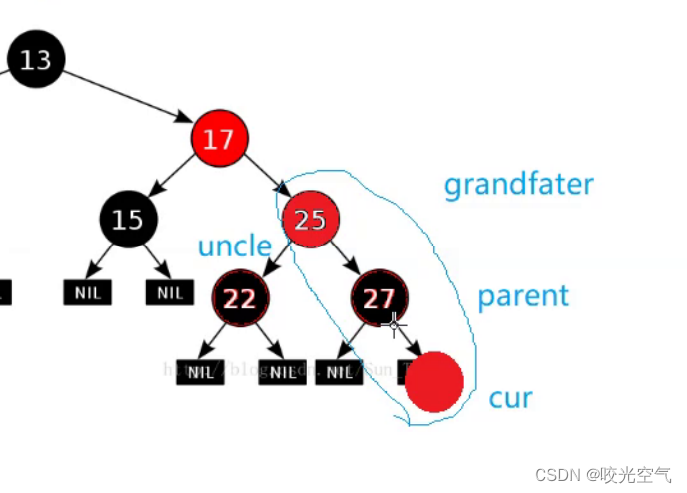
这样之后还需要判断,爷节点的父节点如果是黑,那就不做什么,如果是红,就把爷节点当作cur,重复刚才的动作。
相当于parent和uncle变黑,grandfather变红,然后g变为cur,继续向上调整。
当整理完一个子树后,向上调整,还会遇到上方的其他节点的子点的子树。
第2种情况
cur有可能是新增节点为红,也有可能是下面变色而来的红色。

上图中的部分也就是下图中cur之下的那一部分。

为了所有路径都有同样数量的黑节点,cde的情况有四种,都是包含一个黑节点的红黑子树

现在的代码
while (parent&& parent->_col == RED)
{
Node* gf = parent->_parent;
if (gf->_left == parent)
{
Node* uncle = gf->_right;
if (uncle && uncle->_col == RED)
{
parent->_col = BLACK;
uncle->_col = BLACK;
gf->_col = RED;
cur = gf;
parent = cur->_parent;
}
}
}
_root->_col = BLACK;//因为上面的循环有可能把根节点变成红色的,所以出来循环就直接变黑
第3种情况

第三个插入节点的情况,也就是1->6->节点,这时候没有叔叔结点,此时1是黑,6是红,连红肯定不行,那么6要变为黑。因为这个红节点的插入,这个路径相关的性质以及整个树的高度已经变化了,可能最长路径已经是最短路径的二倍多了,所以这里需要旋转,结果就是6成为根,1和红节点都是子节点,并且把1变为红,那么路径性质就符合了。如果插在6的右边,那就左旋。
相当于旋转+变色,parent变黑,grandfather变红,parent做新的根,其余两个为子节点。
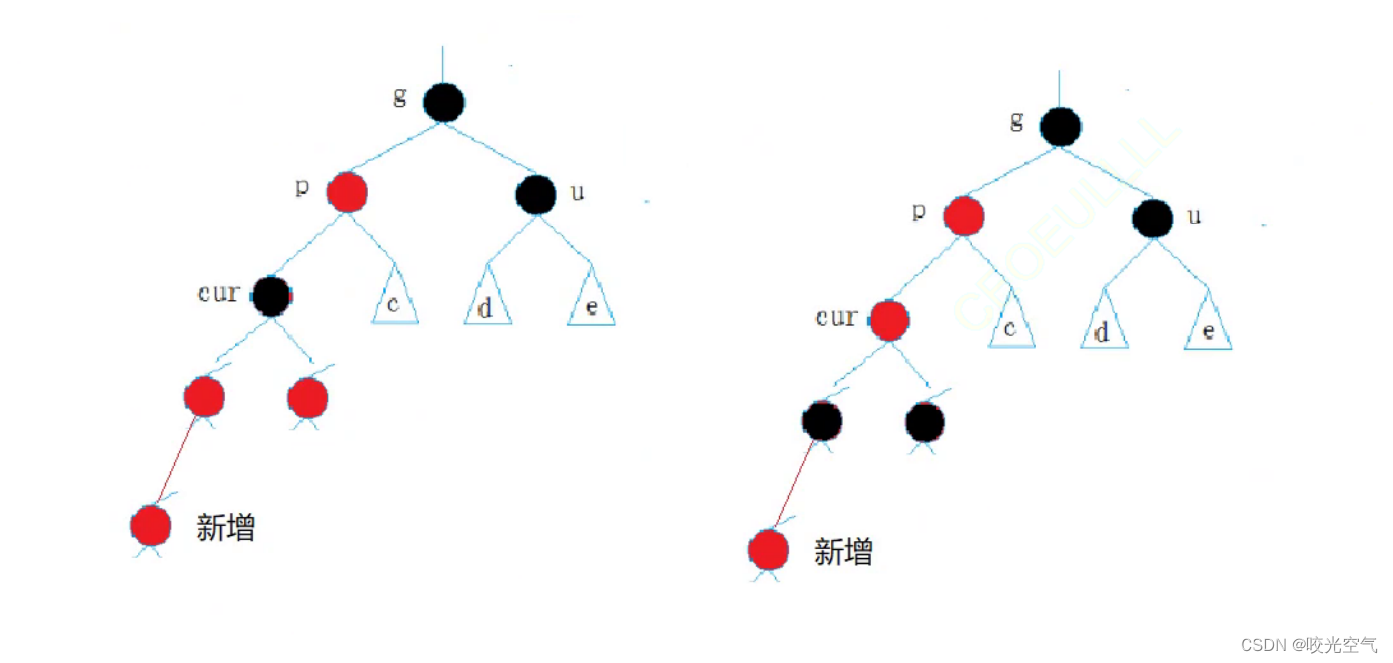
叔叔节点存在且为黑的话,我们还是看cur节点,它为红,cur节点可能以前为黑,之后由下面变色而来,cur就是红色了。为了保证整体路径上黑节点数量的相同,那么c应当是xyzm某一种,然后de可能是空或者红节点,这时候因为左边的子树已经高度超了,所以得旋转

让c成为g的子节点,并对它们进行变色,如果父节点在爷节点左边,那就右旋,右边则左旋。父节点变黑,爷节点变红。
更复杂的情况是这样的。cur为红,是parent的右子节点,parent为红,grandfather为黑,叔叔结点存在且为黑或不存在,不存在就说明cur是新增节点,存在为黑那么cur就是由下面变色而来的。这时候以cur和parent的形状来看,单旋并不能解决问题,所以需要双旋。

以p为轴点进行单旋
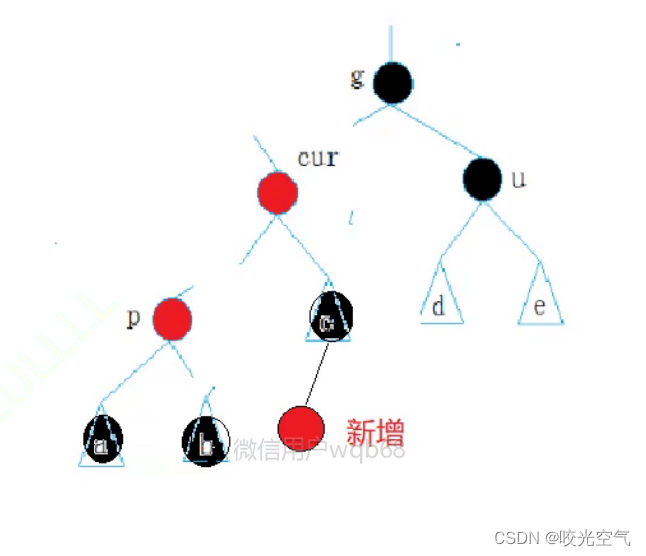
cur的左节点给parent,cur做parent的父节点。
然后对g进行单旋。
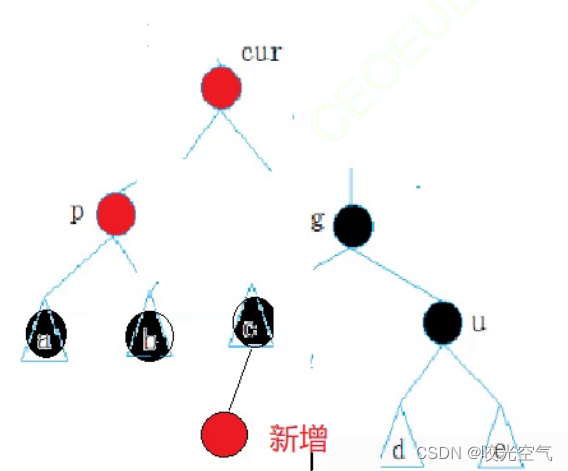
cur剩余的节点给到grandfather的左边,然后cur作为新根。
也就是说叔叔节点不存在或存在且为黑时,需要旋转,如果爷,父,子节点是一条直线的,那就是单旋,如果是折线,那就是双旋。
2、插入代码
bool Insert(const pair<K, V>& data)
{
if (_root == nullptr)
{
_root = new Node(data);
_root->_col = BLACK;
return true;
}
Node* parent = nullptr;
Node* cur = _root;
while (cur)
{
if (cur->_kv.first < data.first)
{
parent = cur;
cur = cur->_right;
}
else if (cur->_kv.first > data.first)
{
parent = cur;
cur = cur->_left;
}
else
{
return false;
}
}
cur = new Node(data);
if (parent->_kv.first > data.first)
{
parent->_left = cur;
}
else
{
parent->_right = cur;
}
cur->_parent = parent;
while (parent && parent->_col == RED)
{
Node* gf = parent->_parent;
if (gf->_left == parent)
{
Node* uncle = gf->_right;
//情况1:u存在且为红,变色处理,并继续往上处理
if (uncle && uncle->_col == RED)
{
parent->_col = BLACK;
uncle->_col = BLACK;
gf->_col = RED;
cur = gf;
parent = cur->_parent;
}
else//情况2+3:u不存在或者u存在且为黑,旋转+变色
{
// g
// p u
// c
if (cur == parent->_left)
{
RotateR(gf);
parent->_col = BLACK;
gf->_col = RED;
}
else
{
// g
// p u
// c
RotateL(parent);
RotateR(gf);
cur->_col = BLACK;
//parent->_col = RED;
gf->_col = RED;
}
break;
}
}
else if(gf->_right == parent)
{
// g
// u p
// c
Node* uncle = gf->_right;
//u存在且为红,变色处理,并继续往上处理
if (uncle && uncle->_col == RED)
{
parent->_col = BLACK;
uncle->_col = BLACK;
gf->_col = RED;
cur = gf;
parent = cur->_parent;
}
else//u不存在或者u存在且为黑,旋转+变色
{
// g
// u p
// c
if (cur == parent->_right)
{
RotateL(gf);
gf->_col = RED;
parent->_col = BLACK;
}
else
{
// g
// u p
// c
RotateR(parent);
RotateL(gf);
cur->_col = BLACK;
gf->_col = RED;
}
break;
}
}
}
_root->_col = BLACK;
return true;
}
void RotateL(Node* parent)
{
Node* subR = parent->_right;
Node* subRL = subR->_left;
parent->_right = subRL;
if (subRL)
subRL->_parent = parent;
Node* ppnode = parent->_parent;
subR->_left = parent;
parent->_parent = subR;
if (ppnode == nullptr)
{
_root = subR;
_root->_parent = nullptr;
}
else
{
if (ppnode->_left == parent)
{
ppnode->_left = subR;
}
else
{
ppnode->_right = subR;
}
subR->_parent = ppnode;
}
}
void RotateR(Node* parent)
{
Node* subL = parent->_left;
Node* subLR = subL->_right;
parent->_left = subLR;
if (subLR)
subLR->_parent = parent;
Node* ppnode = parent->_parent;
subL->_right = parent;
parent->_parent = subL;
if (parent == _root)
{
_root = subL;
_root->_parent = nullptr;
}
else
{
if (ppnode->_left == parent)
{
ppnode->_left = subL;
}
else
{
ppnode->_right = subL;
}
subL->_parent = ppnode;
}
}
3、测试是否是红黑树
判断路径2倍这个点不可取,不是充要条件。我们要判断的是根节点颜色,是否有连红,以及黑节点的数量。我们可以添加一个blackNum以及定义一个benchmark变量。根据性质来判断即可。
void IsBalance()
{
if (_root && _root->_col == RED)
{
cout << "根节点是红色" << endl;
return false;
}
int benchmark = 0;//黑节点参考值,选择一条路径上的黑节点数量做参考值即可
Node* cur = _root;
while (cur)
{
if (cur->_col == BLACK) ++benchmark;
cur = cur->_left;
}
return _Check(_root, 0, benchmark);
}
bool _Check(Node* root, int blackNum, int benchmark)
{
if (root == nullptr)
{
if (benchmark != blackNum)
{
cout << "某条路径黑节点的数量不相等" << endl;
return false;
}
return true;
}
if (root->_col == BLACK) ++blackNum;
if (root->_col == RED
&& root->_parent
&& root->_parent->_col == RED)
{
cout << "存在连续的红色节点" << endl;
return false;
}
return _Check(root->_left, blackNum, benchmark)
&& _Check(root->_right, blackNum, benchmark);
}
int _High(Node* root)//测量高度
{
if (root == NULL) return 0;
int leftH = _High(root->_left);
int rightH = _High(root->_lright);
return leftH > rightH ? leftH + 1 : rightH + 1;
}
4、完整代码
enum Colour
{
RED,
BLACK,
};
template<class K, class V>
struct RBTreeNode
{
RBTreeNode<K, V>* _left;
RBTreeNode<K, V>* _right;
RBTreeNode<K, V>* _parent;
pair<K, V> _kv;
Colour _col;
RBTreeNode(const pair<K, V>& kv)
:_left(nullptr)
, _right(nullptr)
, _parent(nullptr)
, _kv(kv)
, _col(RED)
{
}
};
template<class K, class V>
class RBTree
{
typedef RBTreeNode<K, V> Node;
public:
~RBTree()
{
_Destroy(_root);
_root = nullptr;
}
Node* Find(const K& key)
{
Node* cur = _root;
while (cur)
{
if (cur->_kv.first < key)
{
cur = cur->_right;
}
else if (cur->_kv.first > key)
{
cur = cur->_left;
}
else
{
return cur;
}
}
return nullptr;
}
bool Insert(const pair<K, V>& kv)
{
if (_root == nullptr)
{
_root = new Node(kv);
_root->_col = BLACK;
return true;
}
Node* parent = nullptr;
Node* cur = _root;
while (cur)
{
if (cur->_kv.first < kv.first)
{
parent = cur;
cur = cur->_right;
}
else if (cur->_kv.first > kv.first)
{
parent = cur;
cur = cur->_left;
}
else
{
return false;
}
}
cur = new Node(kv);
if (parent->_kv.first > kv.first)
{
parent->_left = cur;
}
else
{
parent->_right = cur;
}
cur->_parent = parent;
while (parent && parent->_col == RED)
{
Node* gf = parent->_parent;
if (gf->_left == parent)
{
Node* uncle = gf->_right;
// u存在且为红,变色处理,并继续往上处理
if (uncle && uncle->_col == RED)
{
parent->_col = BLACK;
uncle->_col = BLACK;
grandfather->_col = RED;
// 继续往上调整
cur = gf;
parent = cur->_parent;
}
else // u不存在/u存在且为黑,旋转+变色
{
// g
// p u
// c
if (cur == parent->_left)
{
RotateR(gf);
parent->_col = BLACK;
gf->_col = RED;
}
else
{
// g
// p u
// c
RotateL(parent);
RotateR(gf);
cur->_col = BLACK;
//parent->_col = RED;
gf->_col = RED;
}
break;
}
}
else if(gf->_right == parent)
{
// g
// u p
// c
Node* uncle = gf->_left;
// u存在且为红,变色处理,并继续往上处理
if (uncle && uncle->_col == RED)
{
parent->_col = BLACK;
uncle->_col = BLACK;
gf->_col = RED;
// 继续往上调整
cur = gf;
parent = cur->_parent;
}
else // 情况2+3:u不存在/u存在且为黑,旋转+变色
{
// g
// u p
// c
if (cur == parent->_right)
{
RotateL(gf);
gf->_col = RED;
parent->_col = BLACK;
}
else
{
// g
// u p
// c
RotateR(parent);
RotateL(gf);
cur->_col = BLACK;
gf->_col = RED;
}
break;
}
}
}
_root->_col = BLACK;
return true;
}
void InOrder()
{
_InOrder(_root);
}
bool IsBalance()
{
if (_root && _root->_col == RED)
{
cout << "根节点颜色是红色" << endl;
return false;
}
int benchmark = 0;//黑节点参考值,选择一条路径上的黑节点数量做参考值即可
Node* cur = _root;
while (cur)
{
if (cur->_col == BLACK)
++benchmark;
cur = cur->_left;
}
// 连续红色节点
return _Check(_root, 0, benchmark);
}
int Height()
{
return _Height(_root);
}
private:
void _Destroy(Node* root)
{
if (root == nullptr)
{
return;
}
_Destroy(root->_left);
_Destroy(root->_right);
delete root;
}
int _Height(Node* root)
{
if (root == NULL)
return 0;
int leftH = _Height(root->_left);
int rightH = _Height(root->_right);
return leftH > rightH ? leftH + 1 : rightH + 1;
}
bool _Check(Node* root, int blackNum, int benchmark)
{
if (root == nullptr)
{
if (benchmark != blackNum)
{
cout << "某条路径黑色节点的数量不相等" << endl;
return false;
}
return true;
}
if (root->_col == BLACK)
{
++blackNum;
}
if (root->_col == RED
&& root->_parent
&& root->_parent->_col == RED)
{
cout << "存在连续的红色节点" << endl;
return false;
}
return _Check(root->_left, blackNum, benchmark)
&& _Check(root->_right, blackNum, benchmark);
}
void _InOrder(Node* root)
{
if (root == nullptr)
{
return;
}
_InOrder(root->_left);
cout << root->_kv.first << " ";
_InOrder(root->_right);
}
void RotateL(Node* parent)
{
Node* subR = parent->_right;
Node* subRL = subR->_left;
parent->_right = subRL;
if (subRL)
subRL->_parent = parent;
Node* ppnode = parent->_parent;
subR->_left = parent;
parent->_parent = subR;
if (ppnode == nullptr)
{
_root = subR;
_root->_parent = nullptr;
}
else
{
if (ppnode->_left == parent)
{
ppnode->_left = subR;
}
else
{
ppnode->_right = subR;
}
subR->_parent = ppnode;
}
}
void RotateR(Node* parent)
{
Node* subL = parent->_left;
Node* subLR = subL->_right;
parent->_left = subLR;
if (subLR)
subLR->_parent = parent;
Node* ppnode = parent->_parent;
subL->_right = parent;
parent->_parent = subL;
if (parent == _root)
{
_root = subL;
_root->_parent = nullptr;
}
else
{
if (ppnode->_left == parent)
{
ppnode->_left = subL;
}
else
{
ppnode->_right = subL;
}
subL->_parent = ppnode;
}
}
private:
Node* _root;
};
3、封装map、set
先把析构函数和find都写上
~RBTree()
{
_Destroy(_root);
_root = nullptr;
}
void _Destroy(Node* root)
{
if (root == nullptr)
{
return;
}
_Destroy(root->_left);
_Destroy(root->_right);
delete root;
}
Node* Find(const K& key)
{
Node* cur = _root;
while (cur)
{
if (cur->_kv.first < key)
{
cur = cur->_right;
}
else if (cur->_kv.first > key)
{
cur = cur->_left;
}
else
{
return cur;
}
}
return nullptr;
}
1、解释说明
我们让map和set都是两个模板参数,并且写仿函数来实现对其中变量的提取。也用到了模板复用。
剩下的部分也仔细琢磨代码,其中有注释说明。
KeyOfT是set和map的比较方法,这个放在下面解释。
Set.h
template<class K>
class set
{
struct SetKeyOfT
{
const K& operator()(const K& key)
{
return key;
}
};
private:
RBTree<K, K, SetKeyOfT> _t;//为什么这里要用两个k?为了匹配map的kv,所以set就用两个k,那么模板参数就可以固定下来为3个了。下面有解释。
};
Map.h
template<class K, class V>
class map
{
struct MapKeyOfT
{
const K& operator()(const pair<const K, V>& kv)
{
return kv.first;
}
};
private:
RBTree<K, pair<const K, V>, MapKeyOfT> _t;
};
我们再看RBTree的实现,set传K,map传pair<const K, V>。
RBTree.h
注释里写的都是原来的部分,与现在为了封装而做的改动做对比。
template<class T>//class K, class V
struct RBTreeNode//T也就是map传的pair,set传的K
{
RBTreeNode<T>* _left;//<K, V>
RBTreeNode<T>* _right;
RBTreeNode<T>* _parent;
T _data;//pair<K, V>
Colour _col;
RBTreeNode(const T& data)
:_left(nullptr)
, _right(nullptr)
, _parent(nullptr)
, _data(data)
, _col(RED)
{
}
};
template<class K, class T, class KeyOfT>//class K, class V。这里就体现了一个很好的写法,引入这个KeyOfT是用来做比较的,map和set都有自己的比较方法,除此之外,map是kv,set是k,加上这个模板参数,那么我们难道要写两个类,模板参数分别是K、KeyOfT和K、V、KeyOfT?这样太麻烦了,所以前面就写到set多带一个k,不会影响k,而且RBTree的实现可以只有集成起来
class RBTree
{
typedef RBTreeNode<T> Node;//<K, V>,这里的T,map传过来的就是pair<const K, V>,set就是K,然后再传给RBTreeNode
public:
bool Insert(const T& data)const pair<K, V>& kv
{
if (_root == nullptr)
{
_root = new Node(data);
_root->_col = BLACK;
return true;
}
Node* parent = nullptr;
Node* cur = _root;
KeyOfT kot;//既然set和map的排序方法都写好了,那么就用模板来使用
while (cur)
{
if (kot(cur->_data) < kot(data))//原先的比较换成各自的方法
{
parent = cur;
cur = cur->_right;
}
else if (kot(cur->_data) > kot(data))
{
parent = cur;
cur = cur->_left;
}
else
{
return false;
}
}
cur = new Node(data);
if (kot(parent->_data) > kot(data))
{
parent->_left = cur;
}
else
{
parent->_right = cur;
}
cur->_parent = parent;
//下面部分没有更改,所以就没写
Find不能用第二个模板参数,因为如果是map,它就是pair了。
继续完善一下set和map的文件,插入就调用底层红黑树的插入。
Set.h
template<class K>
class set
{
struct SetKeyOfT
{
const K& operator()(const K& key)
{
return key;
}
};
public:
bool insert(const K& key)
{
return _t.Insert(key);
}
private:
RBTree<K, K, SetKeyOfT> _t;
};
Map.h
template<class K, class V>
class map
{
struct MapKeyOfT
{
const K& operator()(const pair<const K, V>& kv)
{
return kv.first;
}
};
public:
bool insert(const pair<const K, V>& kv)
{
return _t.Insert(kv);
}
private:
RBTree<K, pair<const K, V>, MapKeyOfT> _t;
};
map的insert写上自己的办法,因为我们调用的是map里面的方法,map再传模板参数,使用RBTree类来完成程序。在插入的时候,我们还需要比较元素,map的比较是pair,红黑树底层不知道传过来的T是什么类型,但是map知道,所以红黑树要去调用map里的比较方法。set可以直接返回,但是为了和map形成复用,它也要写一个对应的方法。红黑树里就可以用KeyOfT这个模板参数来实例化一个对象,然后通过对象调用对应的方法,也就是上面代码中的kot。
2、迭代器
下面有完整代码和链接
map和set的迭代器用的都是红黑树的迭代器。如果用红黑树的迭代器,像RBTree::iterator,那么放在set和map里typedef的时候,在后面还得写上typename,因为编译器不知道要取的是类型还是静态变量,所以要这样写
typedef typename RBTree::iterator iterator
set和map里调用的都是底层红黑树迭代器里的方法,源码中是用const迭代器来实现普通和const版本的。
template <class T, class Ref, class Ptr>
struct __RBTreeIterator
{
typedef RBTreeNode<T> Node;
typedef __RBTreeIterator<T, Ref, Ptr> Self;
Node* _node;
__RBTreeIterator(Node* node)
:_node(node)
{
}
Ref operator*()
{
return _node->_data;
}
Ptr operator->()
{
return &_node->_data;
}
bool operator!=(const Self& s)
{
return _node != s._node;
}
};
在RBTree的类里就可以写上
typedef __RBTreeIterator<T, T&, T*> itertaor;
typedef __RBTreeIterator<T, const T&, const T*> const_itertaor;
以及begin和end。红黑树是走中序遍历,所以begin应当从最左节点开始
itertaor begin()
{
Node* cur = _root;
while (cur && cur->_left)
{
cur = cur->_left;
}
return itertaor(cur);//用迭代器类来构造的一个节点,传过去后用模板参数T来构造一个node,赋值给_node
}
itertaor end()
{
return itertaor(nullptr);
}
然后给set里写上对应的begin和end
template<class K>
class set
{
struct SetKeyOfT
{
const K& operator()(const K& key)
{
return key;
}
};
public:
typedef typename RBTree<K, K, SetKeyOfT>::itertaor iterator;//不写typename会编译不过
iterator begin()
{
return _t.begin();
}
iterator end()
{
return _t.end();
}
bool insert(const K& key)
{
return _t.Insert(key);
}
private:
RBTree<K, K, SetKeyOfT> _t;
};
重点是迭代器的++。之前对于一棵二叉树,有递归(前中后序)和非递归(层序)的办法来遍历,现在用第三种方法来遍历。
给个实际使用
it = begin();
while (it != end())
{
cout << *it << " ";
++it;
}
cout << endl;

begin从最左节点开始,所以it先找到1的左节点,为空,然后就指向1,那么it怎么走下一步?从图中看it的下一个位置应当是6,但如果6的左节点不为空,那么it的下一个位置应当是6的左节点,因为红黑树按中序走。如果右树不为空,下一个就是右树的最左节点。
如果右树为空,或者已经走完了,那么下一个是谁?如果从图中看,下一个肯定就是8。也就是说我们要往上找。右为空,就沿着路径,找孩子是父亲的左节点的那个父亲。因为中序遍历,顺序是左子树,根,右子树。如果全部都走完了,也就是走到了27的右,那么整棵树就结束了,按照第二个情况的方法,我们往上找节点,直到找到根的父节点,也就是空,这时候it应当被赋值为空,然后遍历结束。
Self operator++()
{
if (_node->_right)
{
//1、右不为空,下一个就是右子树的最左节点
Node* subLeft = _node->_right;
while (subLeft->_left)
{
subLeft = subLeft->_left;
}
_node = subLeft;//让这个迭代器节点被赋值这个最左节点,就把它移动过来了
}
else
{
//2、右为空,沿着到根的路径,找孩子是父亲左的那个父亲
Node* cur = _node;
Node* parent = cur->_parent;
while (parent && cur == parent->_right)//是右,继续往上走
{
cur = parent;
parent = parent->_parent;
}
_node = parent;
}
return *this;
}
按照上面的图一点点移动it来理解。测试
void test_set1()
{
int a[] = {
16, 3, 7, 11, 9, 26, 18, 14, 15 };
set<int> s;
for (auto e : a)
{
s.insert(e);
}
set<int>::iterator it = s.begin();
while (it != s.end())
{
cout << *it << " ";
++it;
}
cout << endl;
for (auto e : s)
{
cout << e << " ";
}
cout << endl;
}
–则是反过来。右子树 根 左子树。右子树结束了,根还没有结束;左子树结束了,那就往上找孩子是父亲右节点的那个父亲。
Self& operator--()
{
if (_node->_right)
{
//1、左不为空,找左子树的最右节点
Node* subRight = _node->_left;
while (subRight->_right)
{
subRight = subRight->_right;
}
_node = subRight;//让这个迭代器节点被赋值这个最右节点,就把它移动过来了
}
else
{
//2、左为空,沿着到根的路径,找孩子是父亲右的那个父亲
Node* cur = _node;
Node* parent = cur->_parent;
while (parent && cur == parent->_left)//是左,继续往上走
{
cur = parent;
parent = parent->_parent;
}
_node = parent;
}
return *this;
}
可以用之前map的测试用例来
template<class K, class V>
class map
{
struct MapKeyOfT
{
const K& operator()(const pair<const K, V>& kv)
{
return kv.first;
}
};
public:
typedef typename RBTree<K, pair<const K, V>, MapKeyOfT>::itertaor iterator;
iterator begin()
{
return _t.begin();
}
iterator end()
{
return _t.end();
}
bool insert(const pair<const K, V>& kv)
{
return _t.Insert(kv);
}
private:
RBTree<K, pair<const K, V>, MapKeyOfT> _t;
};
void test_map1()
{
map<string, string> dict;
dict.insert(make_pair("sort", "排序"));
dict.insert(make_pair("string", "字符串"));
dict.insert(make_pair("count", "计数"));
dict.insert(make_pair("count", "数值"));
map<string, string>::iterator it = dict.begin();
while (it != dict.end())
{
cout << it->first << ":" << it->second << endl;
++it;
}
cout << endl;
}
3、map的方括号[]和迭代器的完善
要实现迭代器的方括号功能,得修改一下insert,把bool类型换成pair<iterator, bool>,相应地插入函数中的return的true和false也需要改变,Map.h和Set.h中把bool改成pair<iterator, bool>。这样map和set就可以就[]了。插入函数中,插入成功就返回插入节点的迭代器,不成功就是返回false。如果可以插入,原先代码是写cur = new Node(data),不过因为得配合pair,以及cur在下面的调整中如果没有备份就会有问题,所以再写上一个Node* newnode = cur。在最后的return true时就用newnode。
pair<iterator, bool> Insert(const T& data)
{
if (_root == nullptr)
{
_root = new Node(data);
_root->_col = BLACK;
return make_pair(iterator(_root), true);//return true改成了这样
}
KeyOfT kot;
Node* parent = nullptr;
Node* cur = _root;
while (cur)
{
if (kot(cur->_data) < kot(data))
{
parent = cur;
cur = cur->_right;
}
else if (kot(cur->_data) > kot(data))
{
parent = cur;
cur = cur->_left;
}
else
{
return make_pair(iterator(cur), false);
}
}
cur = new Node(data);
Node* newnode = cur;
//......
return make_pair(iterator(newnode), true);//newnode
}
Map中
V& operator[](const K& key)
{
pair<iterator, bool> ret = _t.Insert(make_pair(key, V()));
return ret.first->second;
}
不过这里有个bug,就是不同的编译器可能会出现迭代器中可以修改元素的操作,实际上我们都知道迭代器不能修改,如果单纯地加const,要修改的地方很多,还会出现其他问题。库里的源代码是这样做的,普通和const迭代器都是const迭代器。

但是都用const迭代器就可以做到不修改了吗?在RBTreeNode结构体中,我们可没有写const修饰的成员。先看看源代码在处理这方面做了什么
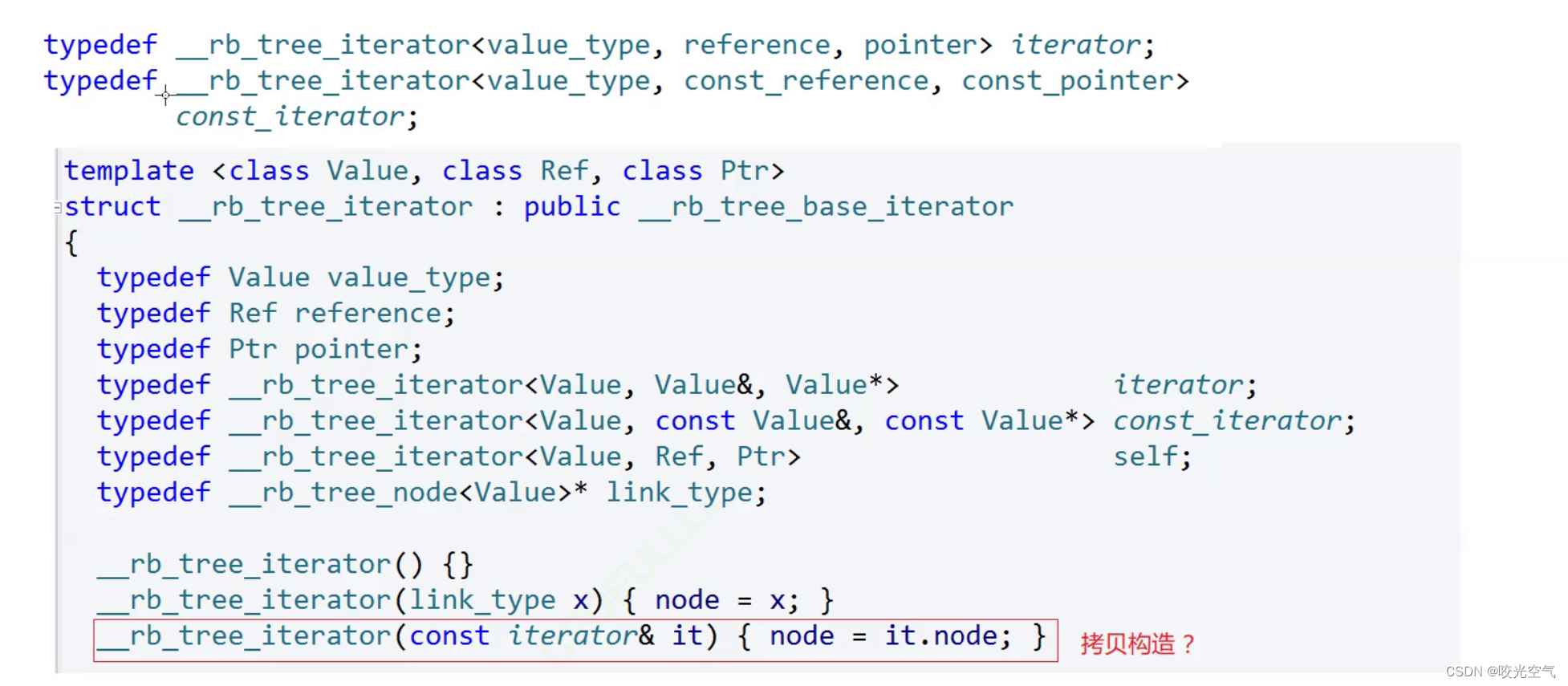
图中是迭代器类。最后一行这里,迭代器的构造函数,const iterator& it,用的是普通迭代器,上面有iterator的typedef,是__rb_tree_iterator<Vlaue, Value&, Value*>。
看一下我们自己的代码
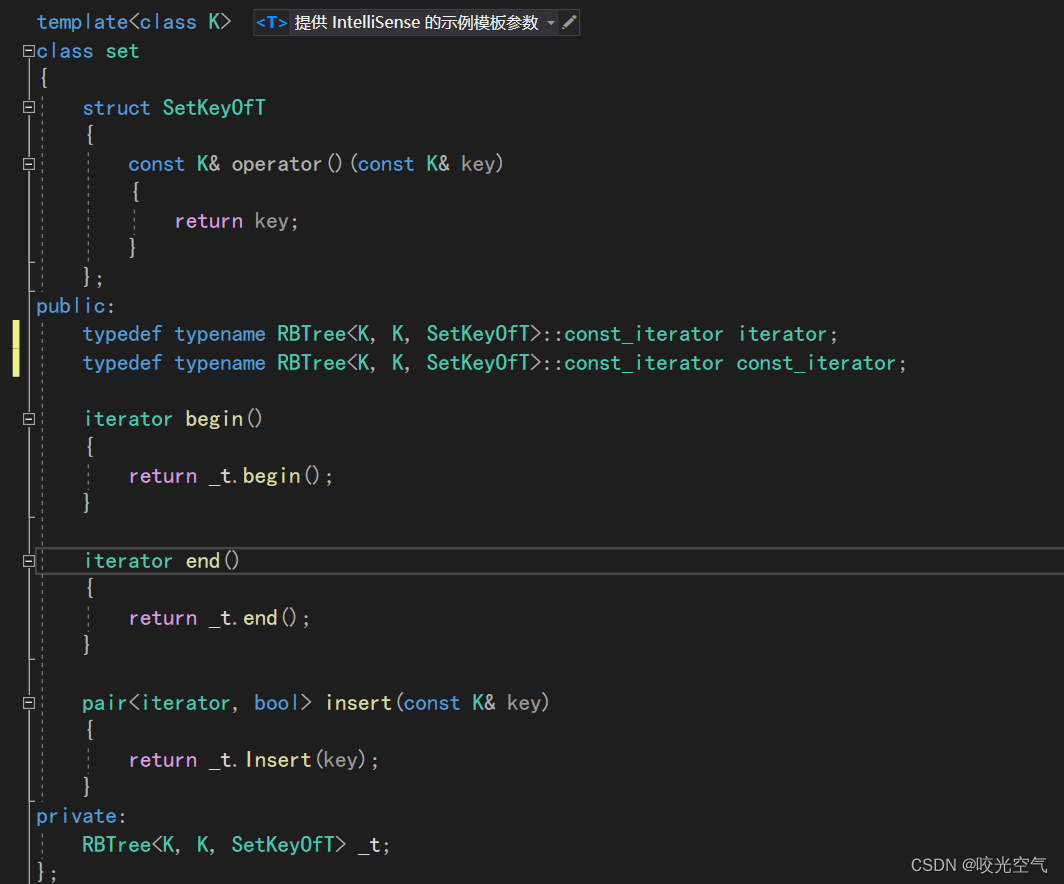
set的迭代器会调用RBTree里的const iterator,那么set的模板参数K,传给RBTree,就会来到RBTree的这一行typedef __RBTreeIterator<T, const T&, const T*> const_itertaor,T也就被换为K

再去找迭代器__RBTreeIterator<T, Ref, Ptr>,这时候这三个模板参数就是T,const T&,const T*,走两个typedef,Node和Self会被创建。我们外面写的时候,会写set< int > s,set< int >::iterator it = s.begin(),s调用begin时,如上图所示,_t.begin(),_t就是RBTree类型的变量,传过去了两个K和SetKeyOfT,由于set里面的begin函数是iterator类型,也就是RBTree里的const_iterator,那么就会调用RBTree类里的const版本的begin函数,begin会将_node的data给it。
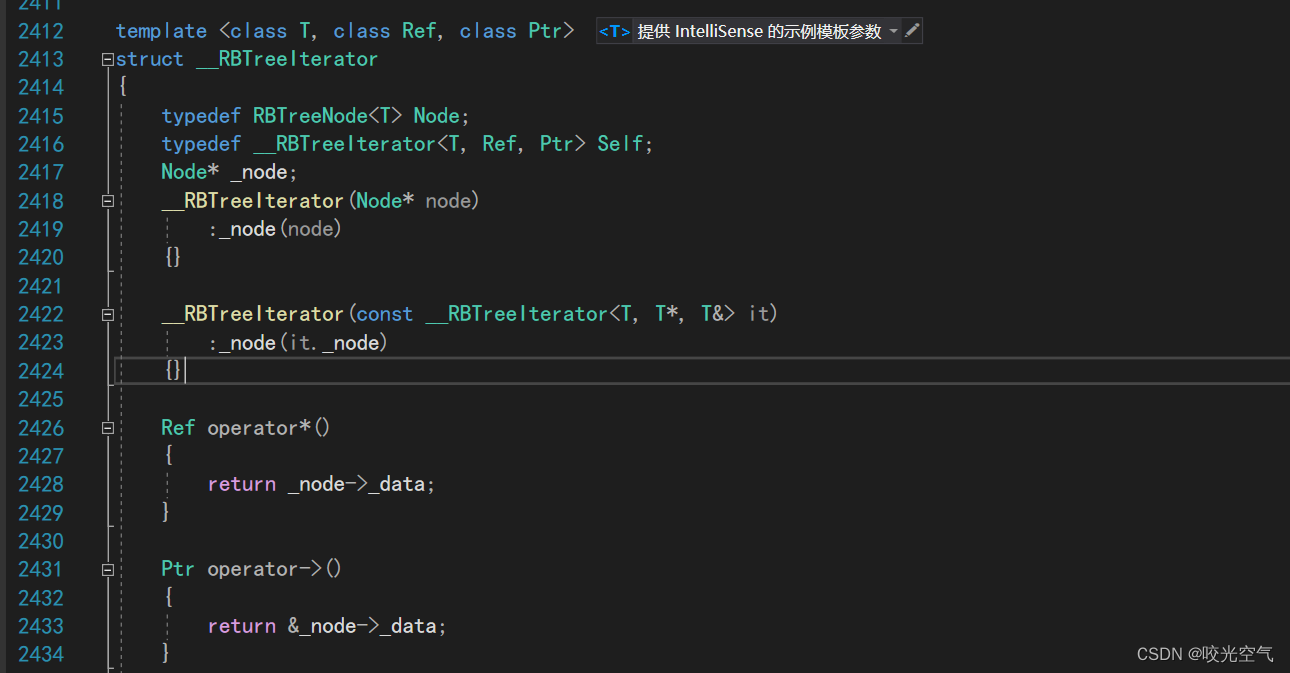
如果迭代器类里只有一个构造函数,也就是括号里是Node* node的那个,那么获取到的当前节点的值是可以修改,因为_node就没有什么限制,在构造这个节点的时候,数据传到RBTreeNode的结构体中
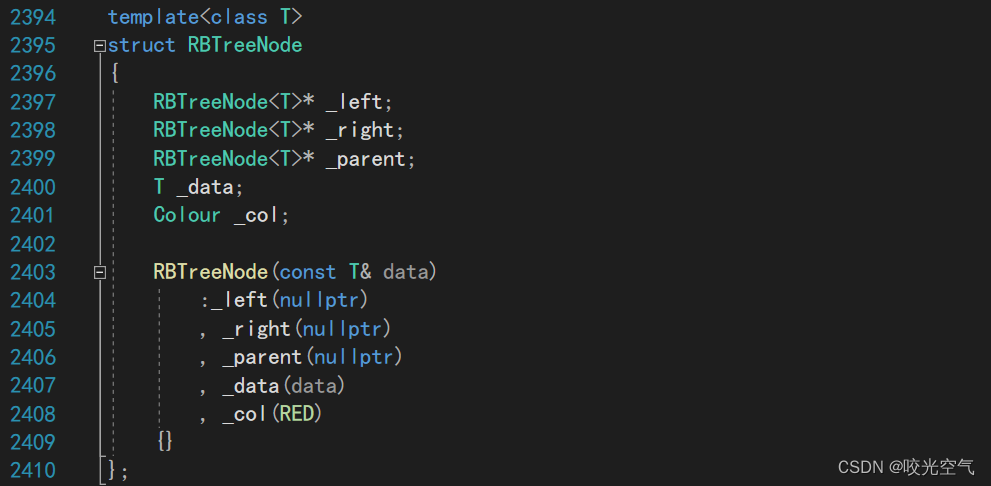
用T来声明一个_data变量,这里就没有限制,所以_node的data就可以更改,所以这样子不行;而第二个构造,对it进行const修饰,然后通过it访问_node,那么这时候因为it是const的,所以它里面的数据就没法更改了,所以使用const迭代器也就真的可以不修改数据了。写到这里,如果在RBTreeNode里写成T _data是不是也能起到不能修改的作用?这确实可以,但是set只是迭代器时不能修改,其它时候还是可以修改key的。
set的迭代器只有const迭代器,只不过set里给它起了两个别名iterator和const iterator,但都是const的。
当然还有其他函数,不过这篇就只写了重要的函数。
4、整体代码
Map.h
template<class K, class V>
class map
{
struct MapKeyOfT
{
const K& operator()(const pair<const K, V>& kv)
{
return kv.first;
}
};
public:
typedef typename RBTree<K, pair<const K, V>, MapKeyOfT>::itertaor iterator;
iterator begin()
{
return _t.begin();
}
iterator end()
{
return _t.end();
}
V& operator[](const K& key)
{
pair<iterator, bool> ret = _t.Insert(make_pair(key, V()));
return ret.first->second;
}
pair<iterator, bool> insert(const pair<const K, V>& kv)
{
return _t.Insert(kv);
}
private:
RBTree<K, pair<const K, V>, MapKeyOfT> _t;
};
Set.h
template<class K>
class set
{
struct SetKeyOfT
{
const K& operator()(const K& key)
{
return key;
}
};
public:
typedef typename RBTree<K, K, SetKeyOfT>::const_itertaor iterator;
typedef typename RBTree<K, K, SetKeyOfT>::const_itertaor const_iterator;
iterator begin()
{
return _t.begin();
}
iterator end()
{
return _t.end();
}
pair<iterator, bool> insert(const K& key)
{
return _t.Insert(key);
}
private:
RBTree<K, K, SetKeyOfT> _t;
};
RBTree.h
enum Colour
{
RED,
BLACK,
};
template<class T>
struct RBTreeNode
{
RBTreeNode<T>* _left;
RBTreeNode<T>* _right;
RBTreeNode<T>* _parent;
T _data;
Colour _col;
RBTreeNode(const T& data)
:_left(nullptr)
, _right(nullptr)
, _parent(nullptr)
, _data(data)
, _col(RED)
{
}
};
template <class T, class Ref, class Ptr>
struct __RBTreeIterator
{
typedef RBTreeNode<T> Node;
typedef __RBTreeIterator<T, Ref, Ptr> Self;
Node* _node;
__RBTreeIterator(Node* node)
:_node(node)
{
}
__RBTreeIterator(const __RBTreeIterator<T, T*, T&> it)
:_node(it._node)
{
}//用普通迭代器实例化,是拷贝构造,是const的话,是支持普通转换成构造const迭代器的构造函数
Ref operator*()
{
return _node->_data;
}
Ptr operator->()
{
return &_node->_data;
}
bool operator!=(const Self& s)
{
return _node != s._node;
}
Self operator++()
{
if (_node->_right)
{
//1、右不为空,下一个就是右子树的最左节点
Node* subLeft = _node->_right;
while (subLeft->_left)
{
subLeft = subLeft->_left;
}
_node = subLeft;//让这个迭代器节点被赋值这个最左节点,就把它移动过来了
}
else
{
//2、右为空,沿着到根的路径,找孩子是父亲左的那个父亲
Node* cur = _node;
Node* parent = cur->_parent;
while (parent && cur == parent->_right)//是右,继续往上走
{
cur = parent;
parent = parent->_parent;
}
_node = parent;
}
return *this;
}
Self& operator--()
{
if (_node->_right)
{
//1、左不为空,找左子树的最右节点
Node* subRight = _node->_left;
while (subRight->_right)
{
subRight = subRight->_right;
}
_node = subRight;//让这个迭代器节点被赋值这个最右节点,就把它移动过来了
}
else
{
//2、左为空,沿着到根的路径,找孩子是父亲右的那个父亲
Node* cur = _node;
Node* parent = cur->_parent;
while (parent && cur == parent->_left)//是左,继续往上走
{
cur = parent;
parent = parent->_parent;
}
_node = parent;
}
return *this;
}
};
template<class K, class T, class KeyOfT>
class RBTree
{
typedef RBTreeNode<T> Node;
public:
~RBTree()
{
_Destroy(_root);
_root = nullptr;
}
public:
typedef __RBTreeIterator<T, T&, T*> itertaor;
typedef __RBTreeIterator<T, const T&, const T*> const_itertaor;
itertaor begin()
{
Node* cur = _root;
while (cur && cur->_left)
{
cur = cur->_left;
}
return itertaor(cur);
}
const_itertaor end() const
{
return itertaor(nullptr);
}
const_itertaor begin() const
{
Node* cur = _root;
while (cur && cur->_left)
{
cur = cur->_left;
}
return itertaor(cur);
}
itertaor end()
{
return itertaor(nullptr);
}
Node* Find(const K& key)
{
Node* cur = _root;
KeyOfT kot;
while (cur)
{
if (kot(cur->_data) < key)
{
cur = cur->_right;
}
else if (kot(cur->_data) > key)
{
cur = cur->_left;
}
else
{
return cur;
}
}
return nullptr;
}
pair<iterator, bool> Insert(const T& data)
{
if (_root == nullptr)
{
_root = new Node(data);
_root->_col = BLACK;
return make_pair(iterator(_root), true);
}
KeyOfT kot;
Node* parent = nullptr;
Node* cur = _root;
while (cur)
{
if (kot(cur->_data) < kot(data))
{
parent = cur;
cur = cur->_right;
}
else if (kot(cur->_data) > kot(data))
{
parent = cur;
cur = cur->_left;
}
else
{
return make_pair(iterator(cur), false);
}
}
cur = new Node(data);
Node* newnode = cur;
if (kot(parent->_data) > kot(data))
{
parent->_left = cur;
}
else
{
parent->_right = cur;
}
cur->_parent = parent;
while (parent && parent->_col == RED)
{
Node* gf = parent->_parent;
if (gf->_left == parent)
{
Node* uncle = gf->_right;
// u存在且为红,变色处理,并继续往上处理
if (uncle && uncle->_col == RED)
{
parent->_col = BLACK;
uncle->_col = BLACK;
grandfather->_col = RED;
// 继续往上调整
cur = gf;
parent = cur->_parent;
}
else // u不存在/u存在且为黑,旋转+变色
{
// g
// p u
// c
if (cur == parent->_left)
{
RotateR(gf);//以gf为轴点
parent->_col = BLACK;
gf->_col = RED;
}
else
{
// g
// p u
// c
RotateL(parent);
RotateR(gf);
cur->_col = BLACK;
//parent->_col = RED;
gf->_col = RED;
}
break;
}
}
else if(gf->_right == parent)
{
// g
// u p
// c
Node* uncle = gf->_left;
// u存在且为红,变色处理,并继续往上处理
if (uncle && uncle->_col == RED)
{
parent->_col = BLACK;
uncle->_col = BLACK;
gf->_col = RED;
// 继续往上调整
cur = gf;
parent = cur->_parent;
}
else // 情况2+3:u不存在/u存在且为黑,旋转+变色
{
// g
// u p
// c
if (cur == parent->_right)
{
RotateL(gf);
gf->_col = RED;
parent->_col = BLACK;
}
else
{
// g
// u p
// c
RotateR(parent);
RotateL(gf);
cur->_col = BLACK;
gf->_col = RED;
}
break;
}
}
}
_root->_col = BLACK;
return make_pair(iterator(newnode), true);
}
void InOrder()
{
_InOrder(_root);
}
bool IsBalance()
{
if (_root && _root->_col == RED)
{
cout << "根节点颜色是红色" << endl;
return false;
}
int benchmark = 0;//黑节点参考值,选择一条路径上的黑节点数量做参考值即可
Node* cur = _root;
while (cur)
{
if (cur->_col == BLACK)
++benchmark;
cur = cur->_left;
}
// 连续红色节点
return _Check(_root, 0, benchmark);
}
int Height()
{
return _Height(_root);
}
private:
void _Destroy(Node* root)
{
if (root == nullptr)
{
return;
}
_Destroy(root->_left);
_Destroy(root->_right);
delete root;
}
int _Height(Node* root)
{
if (root == NULL)
return 0;
int leftH = _Height(root->_left);
int rightH = _Height(root->_right);
return leftH > rightH ? leftH + 1 : rightH + 1;
}
bool _Check(Node* root, int blackNum, int benchmark)
{
if (root == nullptr)
{
if (benchmark != blackNum)
{
cout << "某条路径黑色节点的数量不相等" << endl;
return false;
}
return true;
}
if (root->_col == BLACK)
{
++blackNum;
}
if (root->_col == RED
&& root->_parent
&& root->_parent->_col == RED)
{
cout << "存在连续的红色节点" << endl;
return false;
}
return _Check(root->_left, blackNum, benchmark)
&& _Check(root->_right, blackNum, benchmark);
}
void _InOrder(Node* root)
{
if (root == nullptr)
{
return;
}
_InOrder(root->_left);
cout << root->_kv.first << " ";
_InOrder(root->_right);
}
void RotateL(Node* parent)
{
Node* subR = parent->_right;
Node* subRL = subR->_left;
parent->_right = subRL;
if (subRL)
subRL->_parent = parent;
Node* ppnode = parent->_parent;
subR->_left = parent;
parent->_parent = subR;
if (ppnode == nullptr)
{
_root = subR;
_root->_parent = nullptr;
}
else
{
if (ppnode->_left == parent)
{
ppnode->_left = subR;
}
else
{
ppnode->_right = subR;
}
subR->_parent = ppnode;
}
}
void RotateR(Node* parent)
{
Node* subL = parent->_left;
Node* subLR = subL->_right;
parent->_left = subLR;
if (subLR)
subLR->_parent = parent;
Node* ppnode = parent->_parent;
subL->_right = parent;
parent->_parent = subL;
if (parent == _root)
{
_root = subL;
_root->_parent = nullptr;
}
else
{
if (ppnode->_left == parent)
{
ppnode->_left = subL;
}
else
{
ppnode->_right = subL;
}
subL->_parent = ppnode;
}
}
private:
Node* _root;
};
测试用例
void test_set1()
{
int a[] = {
16, 3, 7, 11, 9, 26, 18, 14, 15 };
set<int> s;
for (auto e : a)
{
s.insert(e);
}
set<int>::iterator it = s.begin();
while (it != s.end())
{
cout << *it << " ";
++it;
}
cout << endl;
for (auto e : s)
{
cout << e << " ";
}
cout << endl;
}
void test_map1()
{
map<string, string> dict;
dict.insert(make_pair("sort", ""));
dict.insert(make_pair("string", "ַ"));
dict.insert(make_pair("count", ""));
dict.insert(make_pair("string", "(ַ)"));
map<string, string>::iterator it = dict.begin();
while (it != dict.end())
{
cout << it->first << ":" << it->second << endl;
/*it->first = "1111";
it->second = "111";*/
++it;
}
cout << endl;
for (auto& kv : dict)
{
cout << kv.first << ":" << kv.second << endl;
}
cout << endl;
}
void test_map2()
{
string arr[] = {
"西瓜", "西瓜", "苹果", "西瓜", "苹果", "苹果", "西瓜", "苹果", "香蕉", "苹果", "香蕉", "梨" };
map<string, int> countMap;
for (auto& e : arr)
{
countMap[e]++;
}
for (auto& kv : countMap)
{
cout << kv.first << ":" << kv.second << endl;
}
}
}
完整代码:红黑树
结束。